Balancing Flood Control and Economic Development in Flood Detention Areas of the Yangtze River Basin
Abstract
:1. Introduction
- (1)
- To analyze the changes in economic factors within the Yangtze River Midstream Urban Agglomeration (YRMUA) and FDAs in the YRB to explore the relationships of economic development between FDAs and nearby cities.
- (2)
- To construct a framework that encompasses the assessment of economic value and flood control value for FDAs in the YRB and identify their trends along with the underlying reasons.
- (3)
- To provide constructive recommendations for the economic development and flood management construction of the FDAs in the YRB based on the results of this study.
2. Materials and Methods
2.1. Study Area
2.2. Data
2.3. Methods
2.3.1. Selection of Indicators
- Indicators of Flood Control Value
- Indicators of Economic Value
2.3.2. Framework of Value Assessment
- The Analytic Hierarchy Process (AHP)
- 1.
- Constructing judgment matrices and determining subjective weight matrices using the 1–9 scale method:In the above equation, represents the weight matrix and denotes the importance ratio of indicator compared to indicator . The weight matrix for flood control value indicators and economic value indicators can be determined based on the importance of indicators presented in Table 2 and Table 3.
- 2.
- Calculate the subjective weight through methods of characteristic root, where the largest eigenvalue is and the corresponding weight vector is .
- 3.
- Perform a consistency check, return to step (1), and reconstruct the weight matrix if it does not pass. Otherwise, use the indicator weights.
- The following is the consistency check process:
- (1)
- Calculate the Consistency Index (CI) using this formula:
- (2)
- Calculate the Consistency Ratio (CR) using this formula:
- (3)
- If CR is less than 0.1, the consistency check is passed, and the last weight of the index is , where is a unit vector. The subjective weights would be determined by this approach.
- The Entropy Weight Method (EW)
- 1.
- Data standardization: Normalize all data and convert negative indicators to positive ones. For indicators with maximum or minimum ordering, we can use min–max normalization to standardize the data. Assuming we have k indicators , …, , where , we can use the following formula for normalization:
- 2.
- Next, calculate the weight for indicator j of research object i:
- 3.
- Determine the weights of each indicator:
- Calculation of the Comprehensive Weight
- Calculating Sort Using TOPSIS
- 1.
- Establish the decision matrix R by multiplying the comprehensive weight with the decision normalized matrix :
- 2.
- Determine the positive and negative ideal solutions for each indicator:
- 3.
- Calculate the degree of correlation using the Euclidean norm, calculate the distance between the evaluation object and the best solution , the distance between the evaluation object and the worst solution , and finally, obtain the proximity of each evaluations object to the ideal solution:The value of ranges between 0 and 1; the closer it is to 1, the higher the flood control value or economic value of the FDA.
2.3.3. Validation of Flood Control Value
- 1.
- Calculate the non-water area inundation rate Sn for each FDA;
- 2.
- Rank the FDAs based on the inundation rate of non-water areas for each FDA;
- 3.
- Calculate the average accuracy of the flood control value for FDAs:
3. Results
3.1. Changes of Land Use, GDP, Population
3.1.1. Changes of Land Use (Impervious)
3.1.2. Changes of GDP and Population
3.2. Changes of Flood Control Value and Economic Value
3.2.1. Changes of Flood Control Value
3.2.2. Changes of Economic Value
3.3. Verification Results for Flood Control Value
4. Discussion
4.1. Changes in Value of FDAs in Yangtze River Basin
4.2. Analysis of Watershed Development and Flood Management
- 1.
- Determine the total volume of water that needs to be diverted by the FDAs during flood dispatch. Due to geographical reasons, the FDAs in the YRB are divided into four regions. Each region needs to divert a certain amount of floodwater during flood dispatch. It is necessary to ascertain the volume of water that needs to be diverted in each region.
- 2.
- In each region, the FDAs to be activated are selected based on a ranking of their flood control value and the volume of floodwater they can store. The selection of FDAs is performed in descending order of their flood mitigation value.
- 3.
- Among the FDAs selected in the previous step, consider their economic value ranking. If a basin has a lower economic value, it is chosen; otherwise, the process reverts to step 2. Finally, verify whether the total volume of floodwater stored meets the requirements. If it does, these FDAs are selected.
4.3. Limitations and Future Prospects
5. Conclusions
- 1.
- The lack of alignment between regional policies and the actual development needs at the local level is evident, as indicated by the fact that flood control policies within the FDAs do not significantly hinder their economic development. This deviation from the initial intent behind establishing these areas highlights a notable discrepancy in the understanding and implementing policies.
- 2.
- The considerable underestimation of the economic development potential of FDAs, particularly in areas surrounding cities, underscores a discrepancy with the initial expectations at the time of their establishment. These areas have proven to contribute significantly more to urban development than the average in the YRMUA. Geographical factors introduce notable variations in the economic development levels and rates among various FDAs.
- 3.
- The observed strong correlation between the flood control value indicators and the extent of non-water area inundation during major flood events suggests a potential avenue for further exploration. Future studies could deeply study the subtle relationship between flood control value and inundation rates to enhance our understanding of their interplay.
Supplementary Materials
Author Contributions
Funding
Data Availability Statement
Conflicts of Interest
References
- Terêncio, D.P.S.; Fernandes, L.F.S.; Cortes, R.M.V.; Moura, J.P.; Pacheco, F.A.L. Flood risk attenuation in critical zones of continental Portugal using sustainable detention basins. Sci. Total Environ. 2020, 721, 137727. [Google Scholar] [CrossRef] [PubMed]
- Bellu, A.; Sanches Fernandes, L.F.; Cortes, R.M.V.; Pacheco, F.A.L. A framework model for the dimensioning and allocation of a detention basin system: The case of a flood-prone mountainous watershed. J. Hydrol. 2016, 533, 567–580. [Google Scholar] [CrossRef]
- Vorogushyn, S.; Lindenschmidt, K.-E.; Kreibich, H.; Apel, H.; Merz, B. Analysis of a detention basin impact on dike failure probabilities and flood risk for a channel-dike-floodplain system along the river Elbe, Germany. J. Hydrol. 2012, 436–437, 120–131. [Google Scholar] [CrossRef]
- Wang, K.; Wang, Z.; Liu, K.; Cheng, L.; Bai, Y.; Jin, G. Optimizing flood diversion siting and its control strategy of detention basins: A case study of the Yangtze River, China. J. Hydrol. 2021, 597, 126201. [Google Scholar] [CrossRef]
- Zhang, X.; Song, Y. Optimization of wetland restoration siting and zoning in flood retention areas of river basins in China: A case study in Mengwa, Huaihe River Basin. J. Hydrol. 2014, 519, 80–93. [Google Scholar] [CrossRef]
- Wang, Y.; Li, N.; Yu, Q.; Wang, J.; Ding, Z.; Han, S. Research on the issues and measures of construction and management of flood storage and detention areas in China. China Flood Drought Manag. 2022, 32, 1–7. [Google Scholar] [CrossRef]
- Wang, L.; Cui, S.; Li, Y.; Huang, H.; Manandhar, B.; Nitivattananon, V.; Fang, X.; Huang, W. A review of the flood management: From flood control to flood resilience. Heliyon 2022, 8, e11763. [Google Scholar] [CrossRef] [PubMed]
- Zhang, J.; Yu, Z.; Yu, T.; Si, J.; Feng, Q.; Cao, S. Transforming flash floods into resources in arid China. Land Use Policy 2018, 76, 746–753. [Google Scholar] [CrossRef]
- Lyu, H.-M.; Xu, Y.-S.; Cheng, W.-C.; Arulrajah, A. Flooding Hazards across Southern China and Prospective Sustainability Measures. Sustainability 2018, 10, 1682. [Google Scholar] [CrossRef]
- Mudashiru, R.B.; Sabtu, N.; Abustan, I.; Balogun, W. Flood hazard mapping methods: A review. J. Hydrol. 2021, 603, 126846. [Google Scholar] [CrossRef]
- Maranzoni, A.; D’Oria, M.; Rizzo, C. Quantitative flood hazard assessment methods: A review. J. Flood Risk Manag. 2023, 16, e12855. [Google Scholar] [CrossRef]
- Qi, W.; Ma, C.; Xu, H.; Chen, Z.; Zhao, K.; Han, H. A review on applications of urban flood models in flood mitigation strategies. Nat. Hazards 2021, 108, 31–62. [Google Scholar] [CrossRef]
- Rahman, M.S.; Di, L. A Systematic Review on Case Studies of Remote-Sensing-Based Flood Crop Loss Assessment. Agriculture 2020, 10, 131. [Google Scholar] [CrossRef]
- Birkinshaw, S.J.; Krivtsov, V. Evaluating the Effect of the Location and Design of Retention Ponds on Flooding in a Peri-Urban River Catchment. Land 2022, 11, 1368. [Google Scholar] [CrossRef]
- Ha, H.; Bui, Q.D.; Nguyen, H.D.; Pham, B.T.; Lai, T.D.; Luu, C. A practical approach to flood hazard, vulnerability, and risk assessing and mapping for Quang Binh province, Vietnam. Environ. Dev. Sustain. 2023, 25, 1101–1130. [Google Scholar] [CrossRef]
- Rözer, V.; Kreibich, H.; Schröter, K.; Müller, M.; Sairam, N.; Doss-Gollin, J.; Lall, U.; Merz, B. Probabilistic Models Significantly Reduce Uncertainty in Hurricane Harvey Pluvial Flood Loss Estimates. Earth’s Future 2019, 7, 384–394. [Google Scholar] [CrossRef]
- Kourtis, I.M.; Tsihrintzis, V.A.; Baltas, E. A robust approach for comparing conventional and sustainable flood mitigation measures in urban basins. J. Environ. Manag. 2020, 269, 110822. [Google Scholar] [CrossRef] [PubMed]
- Meng, Y.; Zhang, H.; Jiang, P.; Guan, X.; Yan, D. Quantitative assessment of safety, society and economy, sustainability benefits from the combined use of reservoirs. J. Clean. Prod. 2021, 324, 129242. [Google Scholar] [CrossRef]
- Zhao, M.; Liu, Y.; Wang, Y.; Chen, Y.; Ding, W. Effectiveness assessment of reservoir projects for flash flood control, water supply and irrigation in Wangmo Basin, China. Sci. Total Environ. 2022, 851, 157918. [Google Scholar] [CrossRef]
- Assaad, R.H.; Assaf, G.; Boufadel, M. Optimizing the maintenance strategies for a network of green infrastructure: An agent-based model for stormwater detention basins. J. Environ. Manag. 2023, 330, 117179. [Google Scholar] [CrossRef]
- Saaty, T.L. A scaling method for priorities in hierarchical structures. J. Math. Psychol. 1977, 15, 234–281. [Google Scholar] [CrossRef]
- Pathan, A.I.; Girish Agnihotri, P.; Said, S.; Patel, D. AHP and TOPSIS based flood risk assessment- a case study of the Navsari City, Gujarat, India. Environ. Monit. Assess. 2022, 194, 509. [Google Scholar] [CrossRef] [PubMed]
- Lyu, H.-M.; Zhou, W.-H.; Shen, S.-L.; Zhou, A.-N. Inundation risk assessment of metro system using AHP and TFN-AHP in Shenzhen. Sustain. Cities Soc. 2020, 56, 102103. [Google Scholar] [CrossRef]
- Dadrasajirlou, Y.; Karami, H.; Mirjalili, S. Using AHP-PROMOTHEE for Selection of Best Low-Impact Development Designs for Urban Flood Mitigation. Water Resour. Manag. 2023, 37, 375–402. [Google Scholar] [CrossRef]
- Liu, Z.; Jiang, Z.; Xu, C.; Cai, G.; Zhan, J. Assessment of provincial waterlogging risk based on entropy weight TOPSIS–PCA method. Nat. Hazards 2021, 108, 1545–1567. [Google Scholar] [CrossRef]
- Ma, S.; Lyu, S.; Zhang, Y. Weighted clustering-based risk assessment on urban rainstorm and flood disaster. Urban Clim. 2021, 39, 100974. [Google Scholar] [CrossRef]
- Song, J.Y.; Chung, E.-S. Robustness, Uncertainty and Sensitivity Analyses of the TOPSIS Method for Quantitative Climate Change Vulnerability: A Case Study of Flood Damage. Water Resour. Manag. 2016, 30, 4751–4771. [Google Scholar] [CrossRef]
- Zhang, H.; Yang, J.; Li, L.; Shen, D.; Wei, G.; Khan, H.u.R.; Dong, S. Measuring the resilience to floods: A comparative analysis of key flood control cities in China. Int. J. Disaster Risk Reduct. 2021, 59, 102248. [Google Scholar] [CrossRef]
- Xu, Z. Binding the Dragon to Catch the Turtle: 70 Years of Flood Control and Disaster Reduction in the Yangtze River; Changjiang Publishing House: Wuhan, China, 2019. [Google Scholar]
- Xia, J.; Chen, J. A new era of flood control strategies from the perspective of managing the 2020 Yangtze River flood. Sci. China Earth Sci. 2021, 64, 1–9. [Google Scholar] [CrossRef]
- Zhong, Z.; Wang, X. Atlas of Flood Storage and Detention Areas in the Yangtze River Basin; Science Press: Beijing, China, 2007. [Google Scholar]
- Yang, J.; Huang, X. The 30 m annual land cover dataset and its dynamics in China from 1990 to 2019. Earth Syst. Sci. Data 2021, 13, 3907–3925. [Google Scholar] [CrossRef]
- ASTER Global Digital Elevation Model V003. Available online: https://lpdaac.usgs.gov/products/astgtmv003/ (accessed on 4 January 2024).
- Pekel, J.-F.; Cottam, A.; Gorelick, N.; Belward, A.S. High-resolution mapping of global surface water and its long-term changes. Nature 2016, 540, 418–422. [Google Scholar] [CrossRef]
- Xu, X. GDP Density Data are from the Kilometre-Grid Data Set of GDP Spatial Distribution of China. 2017. [Google Scholar] [CrossRef]
- Xu, X. Population Density Data are from the Kilometre-Grid Data Set of GDP Spatial Distribution of China. 2017. [Google Scholar] [CrossRef]
- Chen, J.; Gao, M.; Cheng, S.; Hou, W.; Song, M.; Liu, X.; Liu, Y. Global 1 km × 1 km gridded revised real gross domestic product and electricity consumption during 1992–2019 based on calibrated nighttime light data. Sci. Data 2022, 9, 202. [Google Scholar] [CrossRef] [PubMed]
- Peking University. National Main Road Dataset 2000. Available online: https://geodata.pku.edu.cn/ (accessed on 4 January 2024).
- European Commission. Directive 2007/60/EC of the European Parliament and of the Council of 23 October 2007 on the Assessment and Management of Flood Risks. Available online: http://data.europa.eu/eli/dir/2007/60/oj (accessed on 4 January 2024).
- Pham, B.T.; Luu, C.; Phong, T.V.; Nguyen, H.D.; Le, H.V.; Tran, T.Q.; Ta, H.T.; Prakash, I. Flood risk assessment using hybrid artificial intelligence models integrated with multi-criteria decision analysis in Quang Nam Province, Vietnam. J. Hydrol. 2021, 592, 125815. [Google Scholar] [CrossRef]
- Hu, J. The Research of Fast Assessment and Compensation in Exertion Loss of Store Floodwater Area. Master’s Thesis, Hohai University, Nanjing, China, 2005. [Google Scholar]
- Yang, C.; Li, H.; Xu, G.; Xiang, X.; Yang, D. A Measure to the Building Density and Floor Area Ratio of Rural Settlements Based on Da Jiang Unmanned Aerial Vehicle Remote Sensing. Mt. Res. 2019, 37, 144–150. [Google Scholar] [CrossRef]
- Bao, M.; Huang, R. Characteristics of the Interdecadal Variations of Heavy Rain over China in the Last 40 Years. Chin. J. Atmos. Sci. 2006, 30, 1057–1067. [Google Scholar]
- Yuan, X. The Analysis of Spatial and Temporal Evolution Patterns of Urban-Suburb-Countryside in the Middle Yangtze River Basin Urban Agglomeration; Wuhan University: Wuhan, China, 2022. [Google Scholar]
- Liu, Y.; Luo, T.; Liu, Z.; Kong, X.; Li, J.; Tan, R. A comparative analysis of urban and rural construction land use change and driving forces: Implications for urban–rural coordination development in Wuhan, Central China. Habitat Int. 2015, 47, 113–125. [Google Scholar] [CrossRef]
- Feng, Y.; Wang, X.; Du, W.; Liu, J.; Li, Y. Spatiotemporal characteristics and driving forces of urban sprawl in China during 2003–2017. J. Clean. Prod. 2019, 241, 118061. [Google Scholar] [CrossRef]
- Norén, V.; Hedelin, B.; Nyberg, L.; Bishop, K. Flood risk assessment—Practices in flood prone Swedish municipalities. Int. J. Disaster Risk Reduct. 2016, 18, 206–217. [Google Scholar] [CrossRef]
- Ma, M.; Zhao, G.; He, B.; Li, Q.; Dong, H.; Wang, S.; Wang, Z. XGBoost-based method for flash flood risk assessment. J. Hydrol. 2021, 598, 126382. [Google Scholar] [CrossRef]
- Zhang, G.; Zheng, D.; Wu, H.; Wang, J.; Li, S. Assessing the role of high-speed rail in shaping the spatial patterns of urban and rural development: A case of the Middle Reaches of the Yangtze River, China. Sci. Total Environ. 2020, 704, 135399. [Google Scholar] [CrossRef]
- Sun, H.; He, D.; Sui, X.; Chen, Y. Predicting impacts of future climate change and hydropower development towards habitats of native and non-native fishes. Sci. Total Environ. 2020, 707, 135419. [Google Scholar] [CrossRef] [PubMed]
- Wang, J.; Li, N.; Ding, Z.; GUAN, C. Flood risk zoning method in flood storage and detention areas and typical case study. China Flood Drought Manag. 2022, 32, 8–14. [Google Scholar] [CrossRef]
- Thakur, D.A.; Mohanty, M.P. A synergistic approach towards understanding flood risks over coastal multi-hazard environments: Appraisal of bivariate flood risk mapping through flood hazard, and socio-economic-cum-physical vulnerability dimensions. Sci. Total Environ. 2023, 901, 166423. [Google Scholar] [CrossRef] [PubMed]
- Yu, Y.; Liu, Z.; Dong, P.; Lei, X.; You, F.; Yang, Z. Research on reverse order impoundment mode of cascade reservoir flood control system: Case study on upper reaches of Yangtze River. J. Hydrol. 2022, 605, 127348. [Google Scholar] [CrossRef]
- Fang, H.; Han, D.; He, G.; Chen, M. Flood management selections for the Yangtze River midstream after the Three Gorges Project operation. J. Hydrol. 2012, 432–433, 1–11. [Google Scholar] [CrossRef]
- Shan, Y.; Zhongqiong, Y.; Anqiang, L. Study on effects of present upstream flood control system in Changjiang River against 1954 flood. Yangtze River 2018, 49, 9–14+26. [Google Scholar] [CrossRef]
- Xiao, Z.; Yurong, L.; Wenjing, N. Strategy of water projects joint operation program on upper-middle reaches of Changjiang River for controlling 1954 flood under current conditions. Yangtze River 2020, 51, 141–148. [Google Scholar] [CrossRef]
- Zhang, R.; Zhang, X. Spatial–Temporal Differentiation and the Driving Mechanism of Rural Transformation Development in the Yangtze River Economic Belt. Sustainability 2022, 14, 2584. [Google Scholar] [CrossRef]
- Zhang, J.-X.; Cheng, J.-W.; Philbin, S.P.; Ballesteros-Perez, P.; Skitmore, M.; Wang, G. Influencing factors of urban innovation and development: A grounded theory analysis. Environ. Dev. Sustain. 2023, 25, 2079–2104. [Google Scholar] [CrossRef]
- Li, S.; Nadolnyak, D.; Hartarska, V. Agricultural land conversion: Impacts of economic and natural risk factors in a coastal area. Land Use Policy 2019, 80, 380–390. [Google Scholar] [CrossRef]
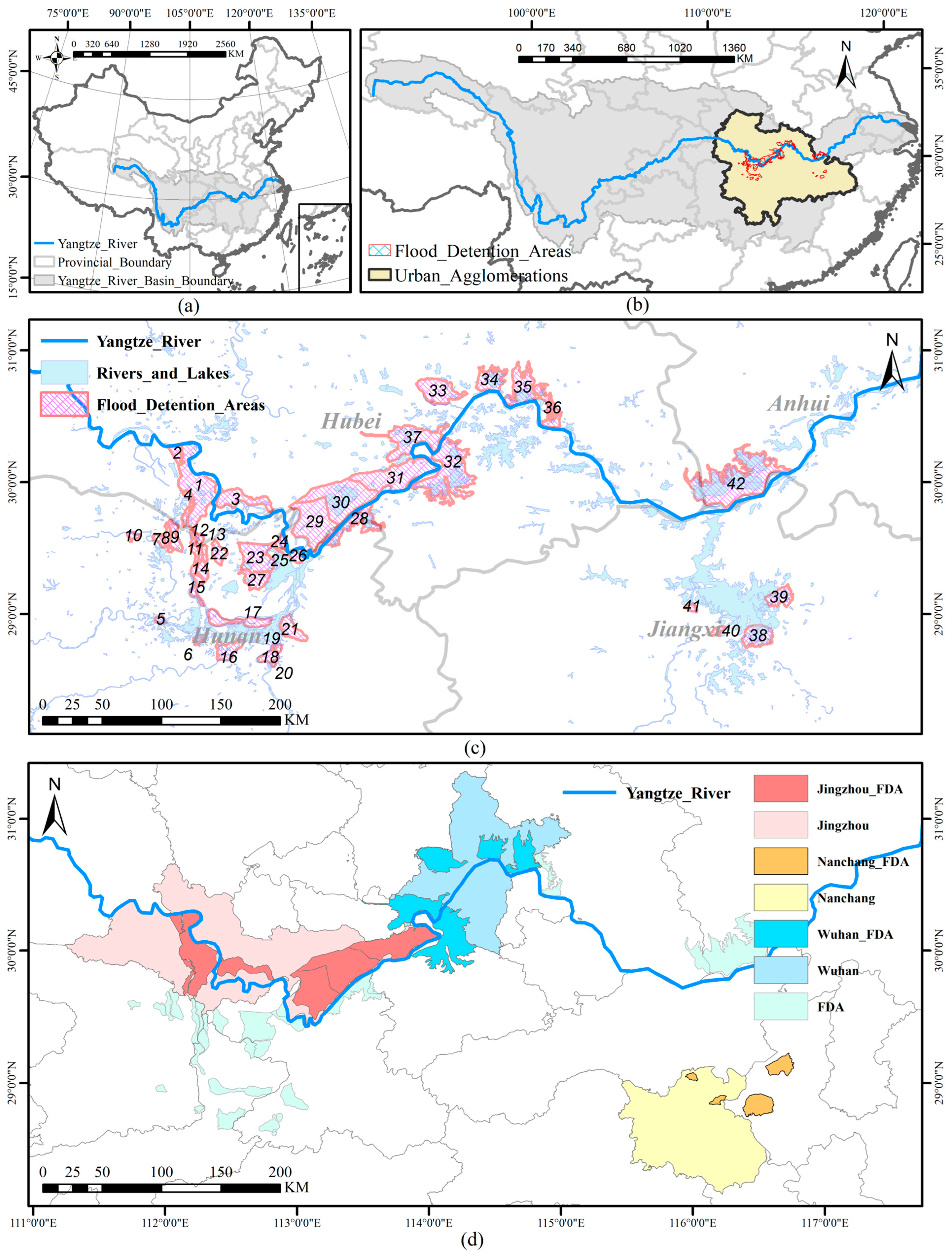
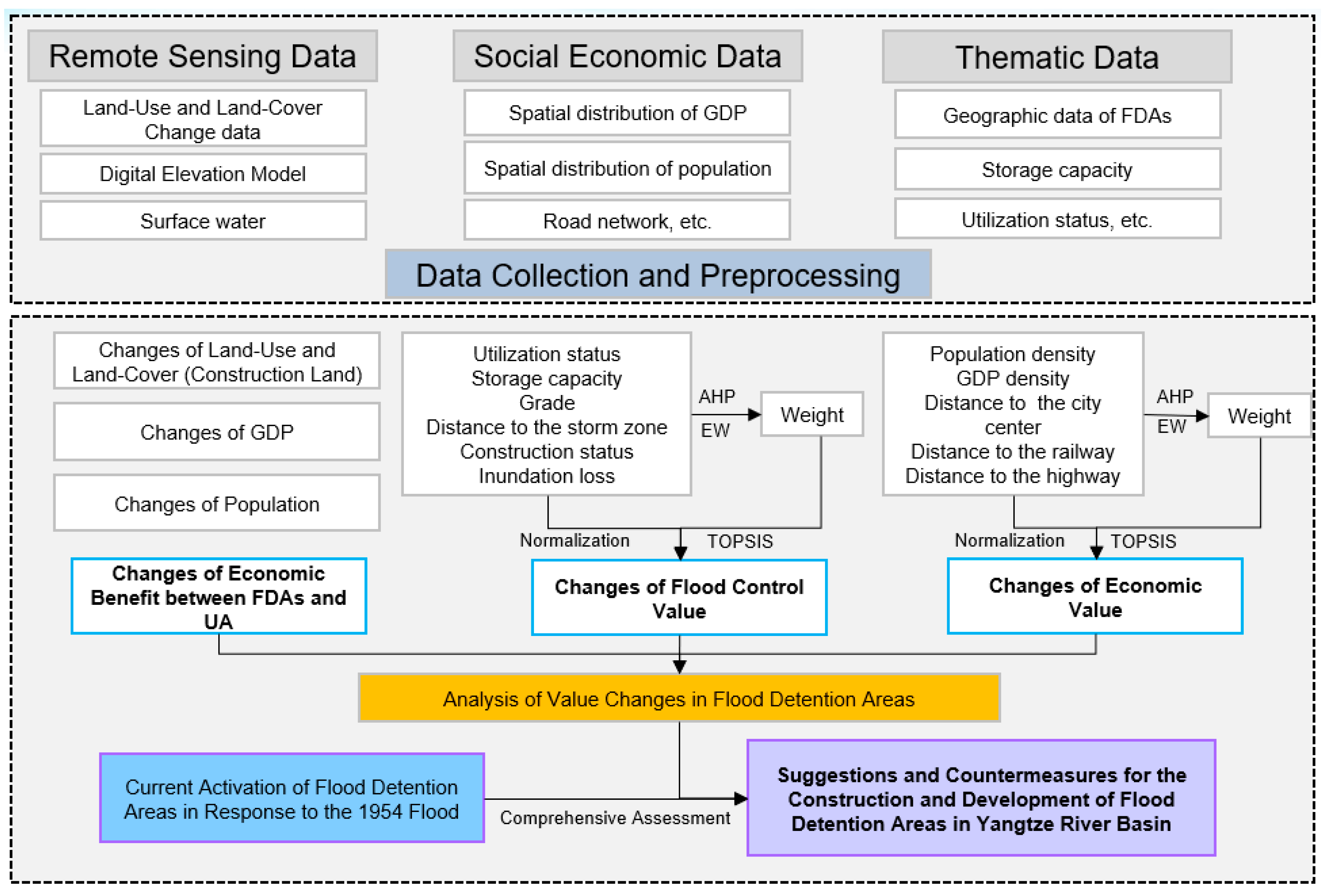
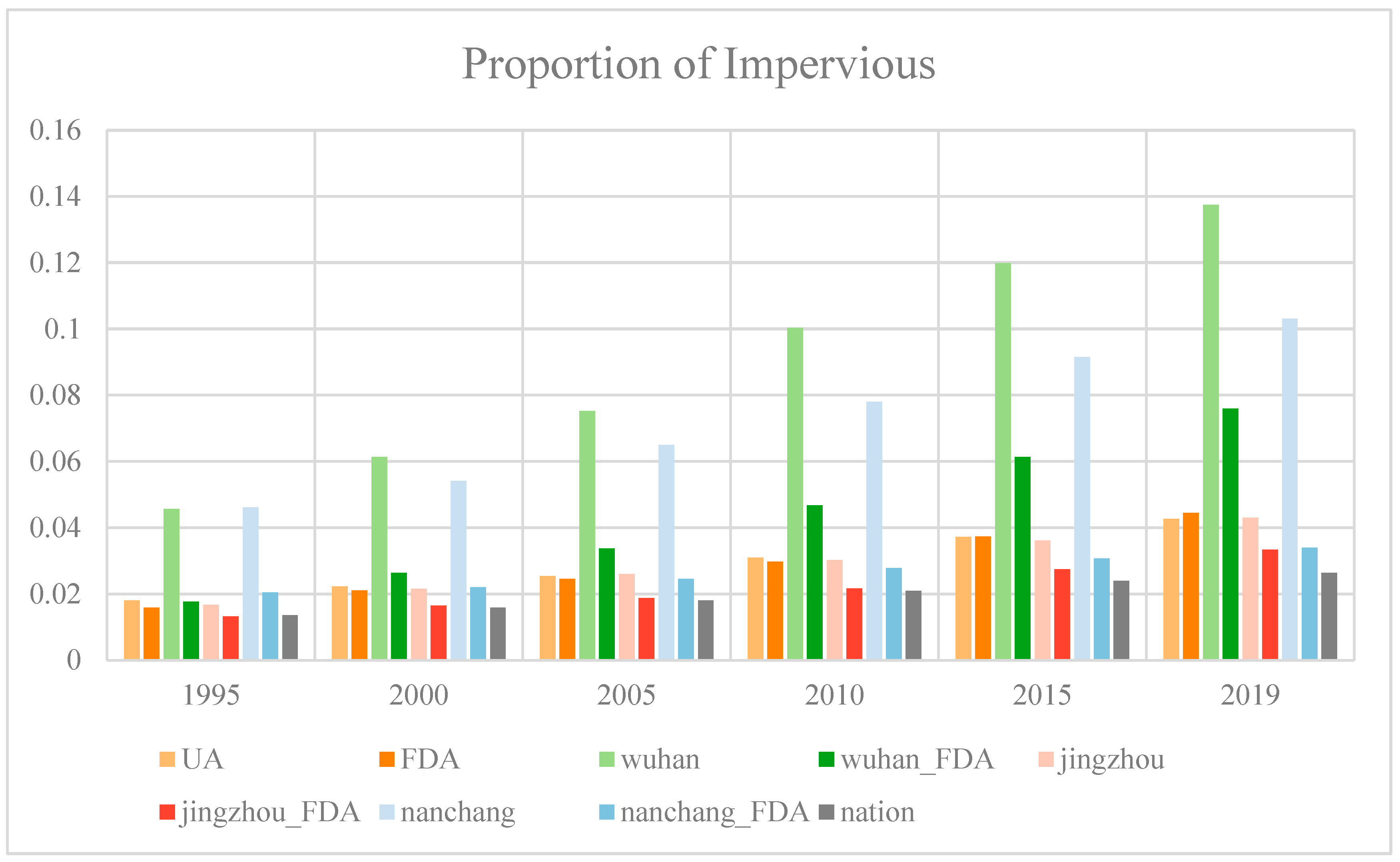
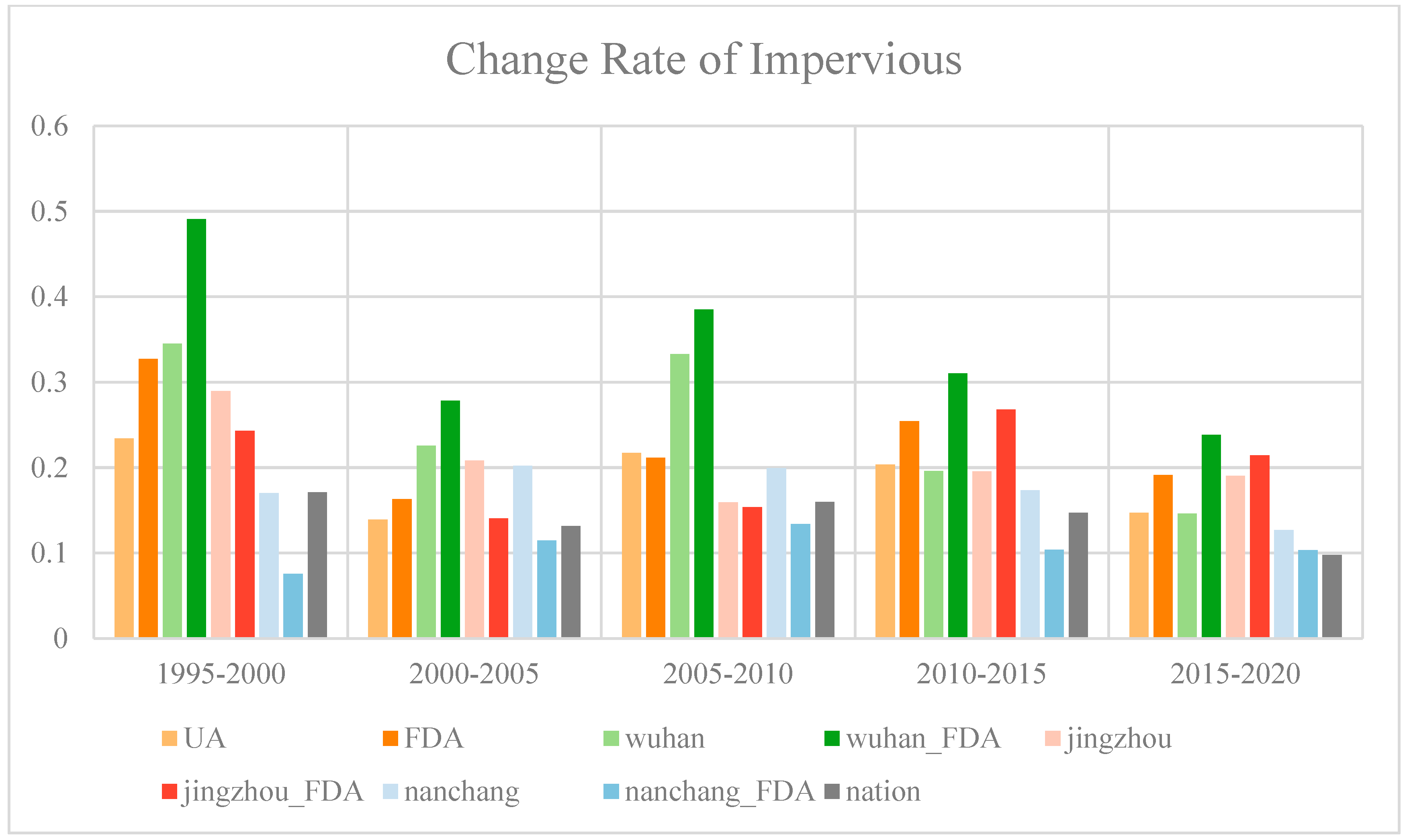









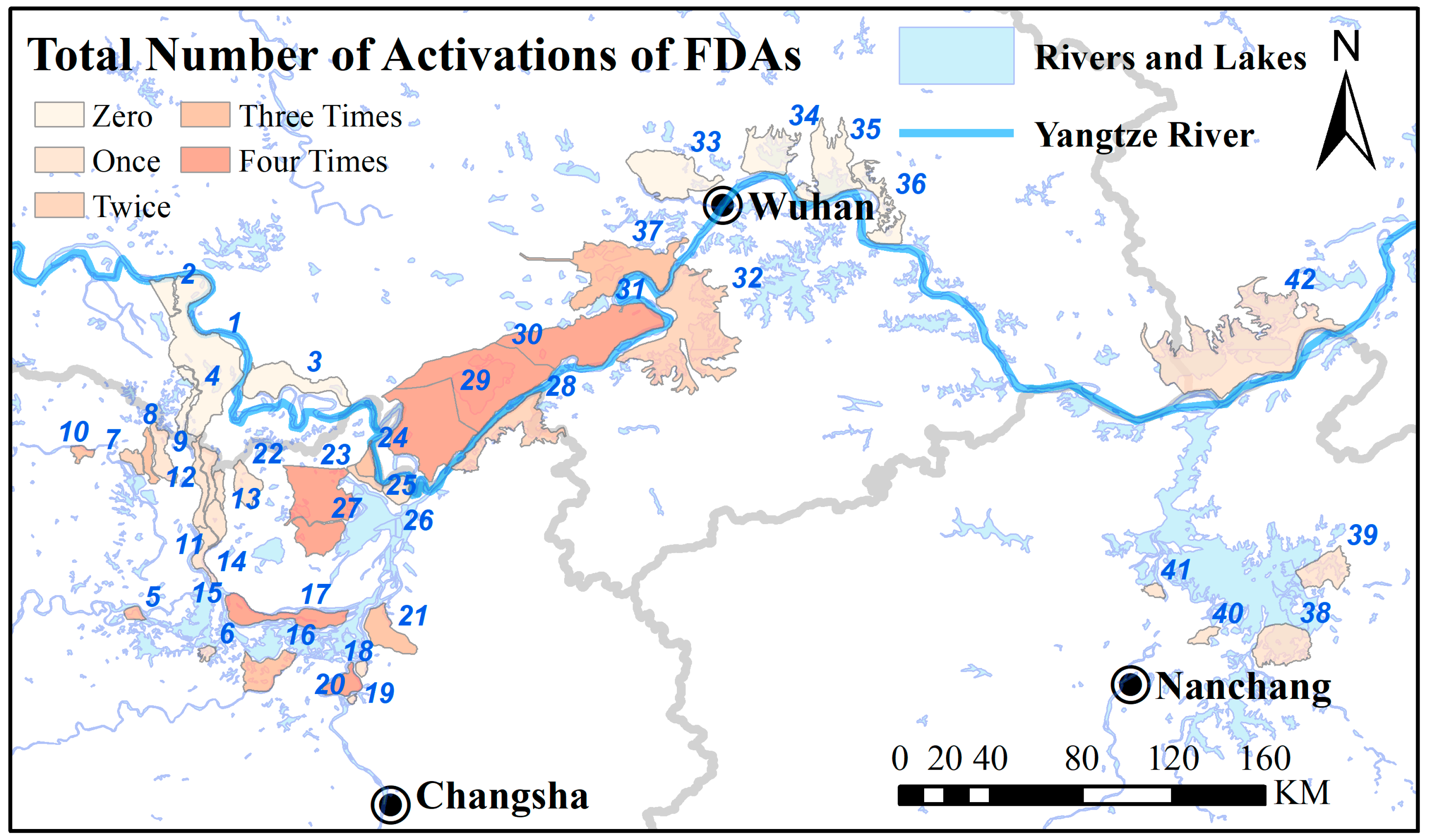
| Data Type | Data | Source | Year | Resolution |
|---|---|---|---|---|
| Land use | 30 m annual land cover and its dynamics in China from 1990 to 2019 | https://essd.copernicus.org/articles/13/3907/2021/ (accessed on 4 January 2024) | 1990–2019 | 30 m |
| DEM | ASTER_GDEM_v3 | https://search.earthdata.nasa.gov/search?q=ASTER (accessed on 4 January 2024) | 2019 | 30 m |
| Surface water | JRC/GSW monthly historical data | Google Engine (accessed on 4 January 2024) | 2016 | 30 m |
| GDP | Spatial distribution of GDP | Chen, J. D. and Gao, M. Global 1 km × 1 km gridded revised real gross domestic product and electricity consumption during 1992–2019 based on calibrated night-time light data. figshare. Dataset. https://doi.org/10.6084/m9.figshare.17004523.v1 (accessed on 4 January 2024) | 1992–2019 | 1 km |
| Population | Spatial distribution of Population | https://www.resdc.cn/DOI/DOI.aspx?DOIID=32 (accessed on 4 January 2024) | 1995–2019 | 1 km |
| Road | Open street map | https://www.openstreetmap.org/ (accessed on 4 January 2024) | 2014–2020 | |
| Road network 2000 | https://geodata.pku.edu.cn/ (accessed on 4 January 2024) | 2000 | ||
| Economic statistics | Output value | http://www.stats.gov.cn/sj/ (accessed on 4 January 2024) |
| Indicators | Details | Positive or Negative for FCV | Importance (1: Max, 9: Min) |
|---|---|---|---|
| Grade | Grade of FDA based on the flood-control conditions within the FDA and the geographical location | Positive | 1 |
| Distance to the storm zone | The distance from the centroid of the FDA to the edge of the storm zone | Negative | 2 |
| Storage capacity | The maximum flood storage capacity per unit area of the FDA | Positive | 1 |
| Utilizations status | The number of activations of the FDA since its establishment in 1954 | Positive | 4 |
| Inundation loss | The inundation loss per unit area when the FDA was activated | Negative | 5 |
| Construction status | The construction status of the FDA | Positive | 7 |
| Indicators | Details | Positive or Negative for FCV | Importance (1: max, 9: min) |
|---|---|---|---|
| GDP | GDP per unit area | Positive | 1 |
| Population | Population per unit area | Positive | 1 |
| Distance to the city center | The distance from the centroid of the FDA to the city center | Negative | 3 |
| Distance to railway | The distance from the centroid of the FDA to railways | Negative | 5 |
| Distance to highway | The distance from the centroid of the FDA to highways | Negative | 8 |
| Proportion of Impervious Area in 1995 | Proportion of Impervious Area in 2020 | GDP Density in 1995 (10,000 CNY/km2) | GDP Density in 2020 (10,000 CNY/km2) | Population Density in 1995 (Person/km2) | Population Density in 2020 (Person/km2) | Change Rate of Impervious Area | Change Rate of GDP | Change Rate of Population | |
|---|---|---|---|---|---|---|---|---|---|
| UA | 0.018 | 0.043 | 389.561 | 1558.435 | 235.836 | 257.684 | 1.364 | 3.000 | 0.093 |
| FDA | 0.016 | 0.044 | 434.253 | 1733.927 | 312.953 | 294.518 | 1.797 | 2.993 | −0.059 |
| Wuhan | 0.046 | 0.137 | 2361.961 | 9421.313 | 550.802 | 648.368 | 2.015 | 2.989 | 0.177 |
| Wuhan_FDA | 0.018 | 0.076 | 1146.182 | 4735.214 | 434.941 | 398.853 | 3.287 | 3.131 | −0.083 |
| Jingzhou | 0.017 | 0.043 | 315.276 | 1115.164 | 293.605 | 260.450 | 1.572 | 2.537 | −0.113 |
| Jingzhou_FDA | 0.013 | 0.033 | 211.865 | 689.897 | 271.590 | 227.067 | 1.520 | 2.256 | −0.164 |
| Nanchang | 0.046 | 0.103 | 969.087 | 4217.442 | 356.137 | 447.209 | 1.232 | 3.352 | 0.256 |
| Nanchang_FDA | 0.020 | 0.034 | 78.097 | 216.105 | 226.806 | 247.441 | 0.657 | 1.767 | 0.091 |
| Nation | 0.014 | 0.026 | 337.566 | 1219.223 | 82.221 | 102.038 | 0.937 | 2.612 | 0.241 |
| Growth Rate | Impervious | GDP | Population |
|---|---|---|---|
| Jingjiang_FDA | 2.09 | 2.614 | −0.191 |
| Dongxihu_FDA | 4.387 | 2.872 | 0.491 |
| Fundamental Principles of Flood Control | FDA Used |
|---|---|
| Plan 1—Raise the operational water level of the Three Gorges Reservoir and implement super high-level operation of downstream levees, with the maximum flood discharge level of the Three Gorges Reservoir being 171.6 m [56] | Qianglianghu FDA, Gongshuangcha FDA, Datonghudong FDA, Honghu East FDA, Honghu Middle FDA, Honghu West FDA, Chengxi FDA |
| Plan 2—The water level of the Three Gorges Reservoir is utilized for flood control up to 163.52 m [55] | Qianlianghu FDA, Gongshuangcha FDA, Datonghudong FDA, Li’nan FDA, Weidihu FDA, Minzhu FDA, Chengxi FDA, Xiguan FDA, Jianshe FDA, Jiuyuan FDA, Quyuan FDA, Jianxin FDA, Jiangnanlucheng FDA, Honghu East FDA, Honghu Middle FDA, Honghu West FDA, Dujiatai FDA, Xilianghu FDA, Kangshan FDA, Zhuhu FDA, Huanghu FDA, Fangzhouxietang FDA, Huayanghe FDA |
| Plan 3—Maintain the flood discharge at the Zhicheng station below 56,700 m3/s, and ensure that the peak water level at the Shashi station does not exceed 42.85 m [54] | Qianlianghu FDA, Gongshuangcha FDA, Datonghudong FDA, Li’nan FDA, Weidihu FDA, Minzhu FDA, Chengxi FDA, Xiguan FDA, Jianshe FDA, Jiuyuan FDA, Quyuan FDA, Jianxin FDA, Jiangnanlucheng FDA, Honghu East FDA, Honghu Middle FDA, Honghu West FDA, Liujiaoshan FDA, Anli FDA, Anchang FDA, Anhua FDA, Nanding FDA, Hekang FDA, Nanhan FDA, Yihe FDA, Beihu FDA, Jichenganhe FDA, Junshan FDA, Dujiatai FDA, Xilianghu FDA |
| Plan 4—Raise the operating water level of the Three Gorges Reservoir and ensure that the peak water level at the Lianhuatang station does not exceed 32.46 m [54] | Qianlianghu FDA, Gongshuangcha FDA, Datonghudong FDA, Li’nan FDA, Weidihu FDA, Minzhu FDA, Chengxi FDA, Xiguan FDA, Jianshe FDA, Jiuyuan FDA, Honghu East FDA, Honghu Middle FDA, Honghu West FDA, Dujiatai FDA |
Disclaimer/Publisher’s Note: The statements, opinions and data contained in all publications are solely those of the individual author(s) and contributor(s) and not of MDPI and/or the editor(s). MDPI and/or the editor(s) disclaim responsibility for any injury to people or property resulting from any ideas, methods, instructions or products referred to in the content. |
© 2024 by the authors. Licensee MDPI, Basel, Switzerland. This article is an open access article distributed under the terms and conditions of the Creative Commons Attribution (CC BY) license (https://creativecommons.org/licenses/by/4.0/).
Share and Cite
Liao, S.; Wang, C.; Ji, R.; Zhang, X.; Wang, Z.; Wang, W.; Chen, N. Balancing Flood Control and Economic Development in Flood Detention Areas of the Yangtze River Basin. ISPRS Int. J. Geo-Inf. 2024, 13, 122. https://doi.org/10.3390/ijgi13040122
Liao S, Wang C, Ji R, Zhang X, Wang Z, Wang W, Chen N. Balancing Flood Control and Economic Development in Flood Detention Areas of the Yangtze River Basin. ISPRS International Journal of Geo-Information. 2024; 13(4):122. https://doi.org/10.3390/ijgi13040122
Chicago/Turabian StyleLiao, Siyuan, Chao Wang, Renke Ji, Xiang Zhang, Zhifei Wang, Wei Wang, and Nengcheng Chen. 2024. "Balancing Flood Control and Economic Development in Flood Detention Areas of the Yangtze River Basin" ISPRS International Journal of Geo-Information 13, no. 4: 122. https://doi.org/10.3390/ijgi13040122
APA StyleLiao, S., Wang, C., Ji, R., Zhang, X., Wang, Z., Wang, W., & Chen, N. (2024). Balancing Flood Control and Economic Development in Flood Detention Areas of the Yangtze River Basin. ISPRS International Journal of Geo-Information, 13(4), 122. https://doi.org/10.3390/ijgi13040122








